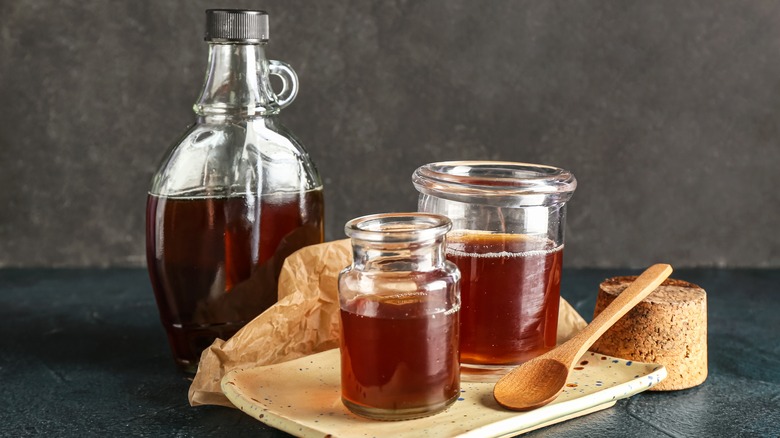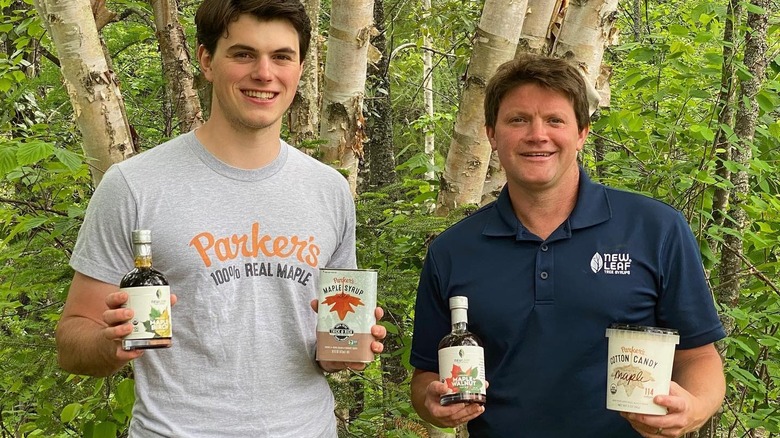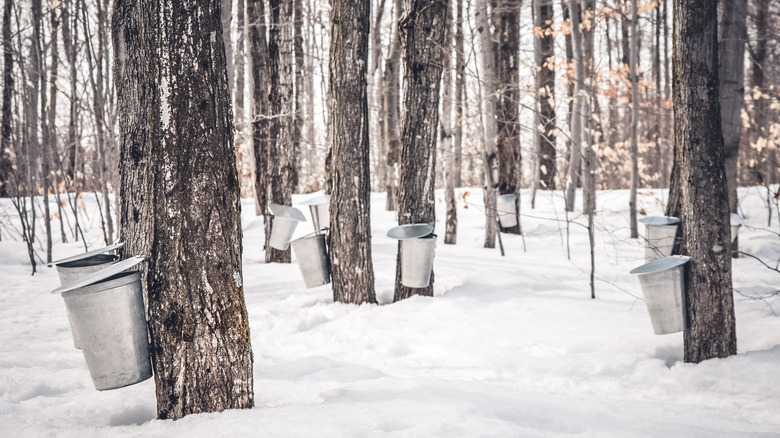Where Is Parker's Maple From Shark Tank Today?
Although northerners will argue bitterly for the pride of having the best maple syrup, one thing is for sure. Whether you're in New Hampshire or New York, Wisconsin or Vermont, Canada or Connecticut, Maine or Minnesota, there's only one true option for your breakfast table, and that's real maple syrup. It's a way of life in the Northwoods.
The "Shark Tank" investors, though, might not have the same appreciation for real maple syrup. They sent Joshua Parker of Parker's Maple Syrup away without a deal. Parker went into the show with a $100,000 deal from Costco and $360,000 in revenue over the previous three years. But the Sharks were less than impressed with his margins, outstanding loans, and sales projections. One by one, they said no to Parker's offer of 20% of Parker's Maple in exchange for $200,000, even though they liked him and the products.
In spite of the Sharks sending Parker away with no deal, Parker's Maple boomed. Since the episode aired in 2016, the maple producer has seen sweet success across syrup, butter, cotton candy, and other maple products in stores, direct orders, and even acquisition.
Parker Maple's sweet success
Within a week of the company's 2016 "Shark Tank" appearance, Parker's Maple sold more than 6,000 units of maple products. Within a year, its products were in thousands of stores nationwide, from Walmart to Wegmans to Whole Foods. And though the Sharks weren't impressed with founder Joshua Parker's margins, the price dropped after Parker's appearance on the show, from $11.99 per bottle to $10.99 direct-to-consumer. (One hopes his high expenses have dropped from $8.46 over the years, too.)
If you're a longtime fan and a syrup connoisseur, you might have noticed a change in the syrup over the last few years. In 2020, Parker announced that his maple company was acquired by The Forest Farmers, an operation in upstate New York focused on conserving wild forests through sustainable sugaring. The acquisition amount was undisclosed, but by 2020, Parker's Maple was estimated to be worth $10 million. Parker's sugaring operation also moved from his family farm to 10,000 acres of forest split between New York and Vermont, potentially changing the terroir of the syrup.
It takes approximately 40 gallons of sap to produce one gallon of syrup, depending on the brix development that year and in that particular sugarbush. Considering how much syrup Parker is making and selling each year, it's clear why he needed to move to a bigger sugarbush.
Making maple syrup
If you're driving through a forest and see flexible tubing running along the trees, it's a sugaring production. Though some small-scale producers, such as Land's Sake Farm in Massachusetts, still tap annually and collect with buckets, most larger producers run sugar lines (and many are left up year-round). As temps rise during the day, so does the sap. And as the night cools, the sap runs back down to the roots. Tapping a maple tree is like a reverse IV; it drips out into the bucket or tubing. The sap is then evaporated, and it thickens into syrup. Once the buds on the tree break and leaf out, the syrup takes on a green chlorophyll note that's less pleasant than pre-bud break sap, limiting sugaring season to early spring.
Other trees can be tapped and used for syrup, including birch and walnut. The Forest Farmer's syrup brand New Leaf makes single tree and blended syrups. Compared to maple, it takes a massive amount of sap to make birch syrup: 110 gallons of birch to maple's 40. But diversifying creates a new, interesting flavor profile and allows The Forest Farmer to focus on long-term sustainability in the face of climate change.
As with any harvest, some years are better than others. The industry is expected to have a great year in 2023, with the weather patterns seen by syrup-producing areas. New England in particular saw an extended sugaring season, which is good news for Parker's Maple.


